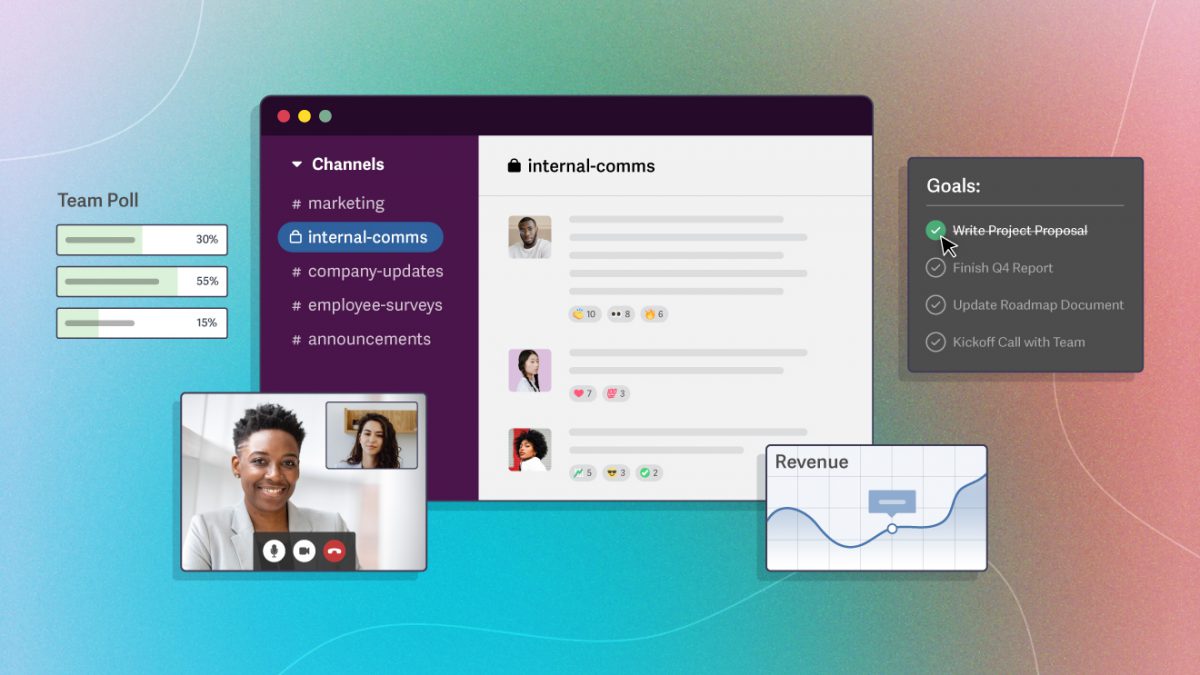It probably won’t take you long to recall a corporate misstep or scandal that either shouldn’t have happened or could have been handled… better.
When employees and executives were asked, “What’s the main cause for workplace failures?” 86% said it was a lack of effective collaboration and communication.
In fact, poor business communication cost corporations (of the 400 surveyed) an average of $62.4 million a year each. Meanwhile, companies with highly effective communication strategies produced 47% higher returns for investors over a five-year period.
Corporate communications isn’t just authentically marketing your brand or ensuring executives communicate with consideration for public relations (though your strategy will do these things).
A well-executed strategy will keep a business functioning optimally and provide a plan for how to effectively communicate when a crisis arises.
We’ll discuss more on why every business needs a communication plan and the plethora of benefits it produces, as well as how to create your business’ communications strategy.
What is a Corporate Communications Strategy?
A corporate communications strategy is a structured plan to effectively and consistently communicate, both internally (across departments, between executives and employees, with investors) and externally (to customers and the public).
There is no single strategy that works universally across companies. A business should structure its own communications plan to address the unique communication needs of that company. We will discuss how to identify and address these needs below.
What a Business Risks Without a Communication Strategy
Only 23% of executives feel that employee goals are efficiently aligned with corporate purpose. Simultaneously, 31% of American companies (21% worldwide) admit to not having any formal plan for internal communication.
Not having a plan at all (think Elon Musk on Twitter) leaves a lot of room for public perception and investor opinion to fluctuate wildly, with no nexus of control from the company itself.
Research has shown that internal communication has a direct impact on customer perception.
Companies generally understand the importance of external communications (i.e. marketing) yet tend to undervalue the benefits — to both employees and the success of the organization — of an effective internal communications strategy.
Additionally, there is always a possibility that internal information will end up being shared externally. Therefore, it is generally wise to assume that all internal communications will eventually be distributed externally. This alone can help protect the company from a lot of potential communication missteps. Ultimately, transparency is the strongest approach.
Benefits of a Communications Strategy
A well-executed communications strategy has the power to improve a workforce’s quality of life while adding to the corporation’s bottom line.

We’ve discussed many benefits with regard to higher investment returns, greater nexus of control, and increased ability to function optimally.
Here’s a list of the various other benefits companies receive through implementing strong communication strategies:
- Employees who work for companies with effective communication plans are 3.5 times more likely to outperform their counterparts.
- Businesses with effective communication have 4.5 times better employee retention than those without it.
- 85% of employees are most motivated when management regularly updates them on company news.
- Research shows that 70% of corporate errors are due to poor communication.
- Employee engagement has a direct impact on increasing a company’s bottom line.
5 Steps to Develop a Corporate Communications Strategy
1. Identify Stakeholders and Audience
The first step to creating your communications strategy is determining with whom your business needs to communicate.
Internally, this might include C-suite executives, employees, and investors. Externally this might include the general public, as well as customers.
You might also consider how to effectively communicate with suppliers, manufacturers, or any other outside organizations that are essential to your business.
This step is essential to creating well-defined goals that tackle all aspects of corporate communications.
2. Gather Feedback from Employees & Customers
Employee feedback is even more important (and challenging) to acquire in the age of work-from-home and hybrid schedules.
Before developing your communications plan, gather anonymous feedback from employees with regard to internal communication and their vision for the company. This in-depth survey should be conducted in a way that allows employees to feel comfortable sharing their sincere thoughts and opinions.
A major part of a successful communications strategy is creating an environment of open communication, meaning employees feel empowered to share their ideas and feel secure sharing criticism that could improve their job and the company.
Externally, it’s also important to solicit feedback from customers with a survey. In exchange for their thorough and honest feedback, consider offering an incentive, such as a discount or free month of service.
This survey should ask customers about their experience receiving communications from your company, which might include what mediums they prefer, the frequency of messaging, the style of communication, what feelings the company’s marketing elicits, why they were persuaded to buy, and more.
3. Create Timely Communication Goals
Executives should outline and compare their future visions of the company. Once each executive has clearly outlined their priorities, the C-suite can align on those priorities and discuss the best method for communicating that vision to the various departments.
Depending on the division of responsibility, this might include collaboration with department teams to evaluate each person’s role and how it fits into the overall vision. This should also include assessing what communications are working well and what needs improvement.
From this collaboration, management should agree upon a set of communication goals for the year with clearly outlined key metrics to measure progress as the plan is implemented.
Keep in mind that your goals will need to consider various aspects of the business, including employee satisfaction, brand reach and conversions, investor expectations, potential crisis situations, and more.
Example of a Corporate Communications Goal
The following goal is one example of how to create a communication goal with metrics that will measure progress and actionable steps for success.
Goal: Improve employee satisfaction and engagement
Metrics for Review:
- Employee retention rates
- Amount of vacation time taken (ensure employees feel comfortable taking time)
- Employee & manager survey responses
- Open rates & watch-times for company-wide communications
Actionable Steps:
- Send out anonymous surveys to employees at beginning and end of year
- Survey managers to better understand challenges and needs
- Host non-work events that build team collaboration and a sense of community
- Executives: model a work-life balance and verbally encourage regular time-off
- Company-sponsored workshop on effective, non-violent communication
- Executives share company updates and successes with personable videos
Create actionable steps with key metrics to evaluate progress. Determine when to evaluate progress and set smaller goals with easy wins to encourage plan adoption.
Keep in mind that some goals are progressive in nature, such as the one used in the example above. There is no clear end point at which this goal is achieved. Instead, the company should create an information baseline and work to improve upon it regularly. Keep diligent notes of this progress to make it easier to create new communication goals each year.
4. Choose the Business’ Communication Tools
How you communicate to employees and customers can have a big impact on their perception of that communication. For example, employees and customers alike have been shown to retain 95% of the information from a video, compared to 10% when reading text.
Companies can utilize this information to increase employee engagement with internal communications. In fact, productivity increases up to 25% when companies use social technologies to improve communication and collaboration.
There are a lot of various tools available, and it can be easy to undervalue the time spent finding the best one for your business.
We’ve tried to expedite this process with our list of the best tools for internal business communication (below). These tools have a massive effect on how well teams are able to collaborate, how productive they can be, and how it feels to interact with the company, or work for it.
Regardless of what tools you choose to employ, centering humanness will always lead to a more positive perception than the cold-feeling neutrality of technological automation.
5. Delegate Communication Responsibilities
Once an organization has clearly defined its communication goals and the actions it will take to further progress, it’s time to decide who will execute and maintain each aspect of the communication plan.
Generally, this will be a natural extension of the departments that already manage that part of the business. For example: Marketing will write and publish press releases, while Human Resources sends out employee surveys.
However, there may also be situations in which multiple departments need to collaborate on how to execute the plan.
When delegating communication responsibilities, collaborate to create clear expectations and realistic timelines.
An effective communications plan will improve the way employees feel at work. Therefore, it’s important the strategy truly supports employees, rather than simply adding more to their to-do list. The same is true with external communication; the goal is to add value through connection.
Bonus: Create a Plan for Crisis Situations
While you can’t plan for everything, it’s wise to consider a few major potential crisis situations.
The specifics of these crises depend on your company’s industry. However, at minimum, your plan should include both internal (i.e. data leak) and external (ie. natural disaster) challenges, and outline how to address them both internally to employees and stakeholders, and externally to the public. The crisis communication plan should include, at minimum:
- How the company will respond
- The channels of approval communications should move through
- A crisis response timeline
- What departments will need to pivot in the event of a crisis
- Funds for allocation or donation in the event of a crisis
The more detailed a crisis communications strategy, the more prepared a company will be when one actually happens. By considering the various things that could go wrong, a company can plan for how to handle challenging situations and prepare accordingly.
The Best Tools For Internal Business Communication
There are different types of technologies that an organization might use for effective communication and a plethora of softwares available in each category. The best internal communication tools are those that align with the needs of your business.
Social Technologies
Social technologies are the social media platforms of internal communication. These tools allow the members of an organization to communicate instantaneously. They are the most used of all the tools on our list as well. They allow teams to collaborate remotely and effectively, but they also help people feel connected to their team throughout the day.
Productivity & Task Organization
These are the tools organizations use to plan and assign projects, keep track of progress, and share relevant information and updates. Often, the effectiveness of these tools depends on how well they are customized to the organization’s needs.
Video Meetings
Virtual team meetings have become commonplace for companies around the world. While Zoom is the most well-known video chat software, there are many different tools that offer this feature, including some we’ve already mentioned (Slack, Discord, etc).
Onboarding & Company Culture
This miscellaneous category includes any softwares your company might use to create and maintain company culture.
Onboarding new hires, for example, is an important part of establishing company culture. This information serves as an introduction to your business, informing employees about the organization they’re joining. Companies may use Google Docs for these purposes; however, Notion has become a common tool as well.
For consistent communication with current employees, consider sending internal newsletters with videos. Tools like Constant Contact allow you to send private employee newsletters, while SproutVideo keeps your internal videos secure.
- Notion (onboarding & culture docs)
- Confluence (onboarding & culture docs)
- SproutVideo (internal videos)
- Staffbase (internal newsletter)
- Constant Contact (internal newsletter)
Think Outside the (Software Tool) Box
Don’t be afraid to get creative and try something new. There are a lot of ways to increase team collaboration. Consider the ways you might strengthen relationships between employees. Some random and fun ideas include:
- Host a virtual scavenger hunt that requires people to work together.
- Play a collaborative video game that’s freely available, such as Among Us.
- Host an internal podcast and invite employees to speak on the work they are doing.
- Cater a long-distance company picnic with DoorDash.
These ideas assume that at least some of your organization works remotely. Local and hybrid teams can also benefit from in-person events held during company time.
Corporate Communication Wins & Failures (Examples)
While no two corporate communications strategies are the same, there is a lot to learn from observing how big companies have handled missteps and scandals in the past.
Whether it was an honest mistake or a full-blown coverup, we’ll look at some of the biggest corporate communication failures, as well as some of the smartest communication strategies that corporations have used to bolster their public image and improve employee satisfaction.
Top Corporate Communication Fails
Volkswagen Emissions Scandal
One corporate failure that had a lasting impact on public perception is the 2016 VW scandal. Not only did the company attempt to thwart regulators on clean air regulations, it went to great lengths to cover it up — and did so successfully for at least a decade.
The scandal cost the company $15 billion in settlement claims.
But one might argue that the true cost for the corporation is a loss of public trust. The way a company chooses to disclose (or actively hide) a difficult truth often affects the public’s perception more than the truth itself. It begs the question, “What else are they hiding?”
Pepsi’s Commercial with Kendall Jenner
In 2017, Pepsi shared its tone-deaf advertisement that featured Kendall Jenner as a protester, solving police brutality by presenting a can of soda to officers.
Public outcry was swift. Pepsi took the ad down. But the damage was done.
While the ad left people wondering how a company could have created such an obviously terrible ad, it became clear that Pepsi failed to both conduct market research and listen to (or center) the voices of activists working to tackle the problem.
Produced in-house, the Pepsi commercial highlighted the importance of creating a corporate communications strategy (and environment) that supports the input and leadership of people of color, as well as other marginalized groups.
Better.com’s Unfortunate Zoom Meeting
A month before Christmas in 2021, the mortgage company, Better.com laid off 900 employees in a Zoom meeting. After rambling about his “not great news,” the CEO, Vishal Garg blankly stated, “If you’re on this call, you are part of the unlucky group that is being laid off.”
The story and video of the meeting was quickly picked up by both journalism and gossip websites. Garg’s tone was reported as being, “unapologetic,” with his early statements showcasing a man more concerned about not crying, rather than how it would affect the 900 people on the call.
He later accused those employees of stealing from the company by being unproductive and held an additional Zoom meeting to warn the remaining employees that their productivity was being watched. The company responded by putting Garg on a hiatus from his CEO position, to which he returned at the end of January in 2022.
This company’s communication scandal is such a trainwreck that it’s hard to evaluate what could have been done differently, since the answer is everything.
McDonald’s Szechuan Sauce Debacle
It all started with an episode of Rick & Morty. One of the main characters, Rick just wants a taste of the McDonald’s Szechuan Sauce that was released during theater promotions for Mulan in 1998 (which is arguably problematic on its own).
This Rick & Morty episode brought back nostalgic desires for fans of the show, and the hype eventually led McDonald’s to bring the sauce back for a limited time.
However, the company massively underestimated fan response. With additional supply chain issues adding to the disaster, this winning promotion led to a lot of irritated customers — with the sauce skyrocketing to ridiculous amounts ($1000 for one sauce) on the secondary market.
The company has released the sauce twice since, but it wasn’t able to take advantage of the potential benefits created by that initial hype. This is a great example of poor communication between a company and its suppliers, as well as the company and its customers. McDonalds failed to recognize the immensity of a fanbase and plan accordingly.
Winning Communication Strategies
GE’s Interview with LinkedIn
In 2016, General Electric recognized it needed to modernize their culture and corporate communications strategy. To communicate this internal shift to the public, Jeff Immelt (CEO of GE) sat down for a video interview with the Senior Editor of Linkedin.
Why Linkedin and not a major news publication?
GE knew the audience they wanted to reach would be on LinkedIn. By strategically using social media to share this external communication, GE was able to share its message with existing employees and prospective recruits — all the while building a reputation of transparency.
IHOP’s Name Change
In 2018, IHOP announced it would be changing its name to IHOb. The announcement was a promotional tactic to create buzz for the chain’s burger menu.
But everyone lost their mind over it. Customers were in an uproar, fully believing that the chain was actually planning to change their name.
Instead of backtracking or explaining the joke, IHOP leaned into the chaos of it all with an official IHOb twitter account dedicated to promoting the burgers.

Soon, everyone was jumping on the bandwagon, with celebrities making jokes and other companies creating funny jabs, such as Wendy’s tweet, “Not really afraid of burgers from a place that decided pancakes are too hard.”
The marketing campaign was a massive success. The company sold four times as many burgers as it previously had, with same-store sales growing 1.2 percent in the third quarter alone. At the height of the hoopla, IHOP sold 500,000 burgers a week.
While this marketing strategy was a risk, it also created a lot of laughter. Ultimately, the brand was able to effectively promote their burgers with a campaign that feels light-hearted and silly.
Netflix Launches in France
Netflix was weary of launching in France in 2014. The audience was skeptical and the corporation would need to be highly relevant. Recognizing the risk, Netflix hired an advertising company to thoroughly dive into the French mindset.
The company launched a GIF-based campaign across advertising screens in the country with highly contextualized ads. For example: if it was raining, the advertisement would feature a character from a Netflix movie or TV show in the rain.
The company tripled its brand awareness in three months, and Netflix was able to successfully enter the country’s market.
This communications strategy, in particular, highlights the importance of thorough research. The advertising agency did the research necessary to understand the challenges Netflix faced when appealing to the French. This led to the campaign being both effective and successful.
Steve Jobs’ Internal Launch of ‘Think Different’
When Steve Jobs returned to Apple in 1997, he made a point to communicate both with the customers and the departments to determine what was working and what projects deserved their focus. The result was his decision to cut 70% of the company’s product line.
After two months, Steve Jobs held an internal company meeting where he laid out his vision for the future of the company. In it, he describes the engineers reactions,
“I came out of the meeting with people that had just gotten their projects canceled. And they were three feet off the ground with excitement, because they finally understood where in the heck we were going. And they were really excited about the strategy.”
This single statement showcases how internal communication that values and involves the input of its team creates high-powered companies with naturally motivated employees who feel purposeful. He goes on to discuss his approach to marketing that Apple is still known for today.








